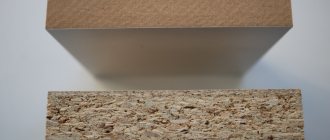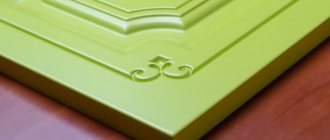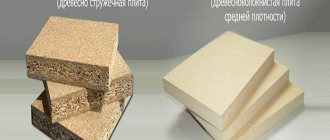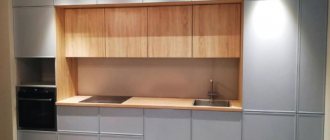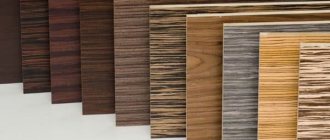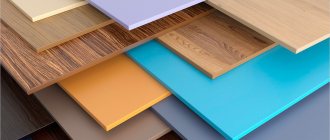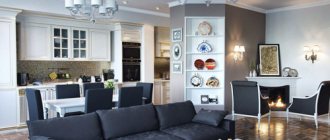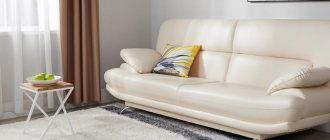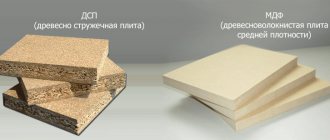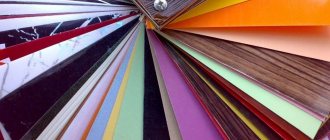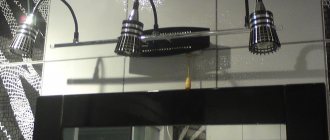High-quality material for kitchen furniture is a guarantee of quality and long service life, so you need to choose it carefully. Today, manufacturers offer furniture made from MDF or laminated chipboard for the kitchen: which is better to purchase and install should be decided based on the characteristics of both materials.
The main advantage of film-laminated chipboard material is its affordable price combined with quality and decorative characteristics. Thanks to its increased density, it perfectly holds the tightening fittings. However, the material cannot be called environmentally friendly, since it is capable of releasing formaldehyde compounds. MDF is more expensive and is very similar to wood, as it has a fibrous structure that allows you to mill furniture facades without restrictions.
What is laminated chipboard - pros and cons for the kitchen
Chipboard - chipboard. It began to be produced at the beginning of the last century. At first, the quality was low, but over time, technology has improved and now it is the most popular material for making furniture, including kitchen furniture. Laminated chipboard is a laminated chipboard, that is, a wood board coated with a protective top layer that gives an aesthetic appearance.
Chipboard production process:
- Wood processing, production of sawdust.
- Grinding sawdust to obtain smaller chips.
- Drying wood pulp in special equipment.
- Wood shavings are sifted to separate the smallest particles, and larger ones are sent for recycling.
- Sorted small shavings are mixed with formaldehyde resin. This synthetic substance is used to glue sawdust and produce a solid, durable layer of chipboard.
- The resulting mixture is sent to the conveyor, where a rough chipboard sheet is formed.
- The workpiece is carefully sanded, the chipboard sheet acquires a smooth, even surface.
- Finishing is the application of a polymer film, which protects against the release of formaldehyde vapors and gives a decorative appearance to the material.
Finished laminated chipboard sheets are cut according to templates of standard sizes.
Advantages of laminated chipboard
Laminated chipboard material has become the most popular in kitchen production due to the following properties that are important for consumers:
- the price of laminated chipboard is lower than that of MDF and solid wood;
- tolerates the effects of humidity and temperature changes in the kitchen;
- durable, resistant to mechanical damage to the surface;
- Almost any chemicals are suitable for washing, except acid-containing ones;
- large selection of colors. On sale there are always chipboards with a colored laminated surface and options made to look like natural wood.
If there are flaws in the laminated chipboard coating, then the resistance to moisture and heat is reduced. For example, the film on the corners of a chipboard sheet is not properly applied and secured. This means that if water gets into the joints, the wood board will soon swell and lose its aesthetic appearance.
If there are voids between the surface of the chipboard and the polymer film, then when it comes into contact with a hot object, such part of the sheet will be deformed.
Disadvantages of laminated chipboard
The main negative point when using laminated chipboard in the kitchen is the formaldehyde content in its composition. When heated, toxic substances can be released into the air, which negatively affects human health. The most dangerous in this regard is chipboard with an uncoated surface, since lamination allows you to reduce the percentage of released toxins.
The content of toxic substances in laminated chipboard discourages many from purchasing a kitchen made from this material. But not everyone knows that there are two types of chipboards - E1 and E2. This marking allows you to choose the safest material.
Type E1 means that per 100 g of chips the resin content is 10 g. In E2, the same amount of sawdust accounts for 30 grams. resin. When choosing laminated chipboard for the kitchen, you should make sure that it is marked E1; such material is relatively safe.
Another negative feature of laminated chipboard is its rigidity; the finished board cannot be processed, and therefore is not suitable for creating shaped products. If you plan to make a kitchen set with a carved pattern, then MDF is suitable for such purposes, but not laminated chipboard. Even for normal cutting, it is necessary to use factory equipment. Cutting with a regular saw will result in chipping.
Features of kitchen countertops made of chipboard
The chipboard sheet serves as a core, which can be lined with material that improves performance characteristics. The production uses wood shavings and formaldehyde resins, which are combined by pressing. To make a kitchen countertop from chipboard, the core is laminated with film or plastic. The protective layer is hot glued in factories.
In the manufacture of MDF, formaldehyde resins are replaced by paraffins, the structure of this material is homogeneous. Most choose laminated chipboard for its acceptable quality combined with low cost. If the cuts are covered with slats, then moisture does not enter the core, which means that harmful volatile components are not released.
To keep the work surface clean, its integrity is important. In small kitchens, to expand the space, countertops are connected to window sills and bar counters. Laminated chipboards have dimensions that allow the production of long working surfaces without joints. The wear resistance increases and the appearance of the headset improves.
What is MDF - pros and cons for the kitchen
MDF material appeared in the USA in the middle of the last century. He came to Russia only in the late 90s. The basis for its manufacture is wood shavings. It is finely ground, so that in the finished MDF sheet the wood fibers are almost invisible. The surface looks uniform, almost like a solid piece of wood.
To make it clearer what is more suitable for the kitchen - chipboard or MDF, let's look at the difference in the manufacture of these materials.
MDF production stages:
- Wood processing, grinding sawdust to a powder texture.
- The ground chips are washed to remove contaminants and sent for drying.
- High pressure pressing. During the process, the wood fibers become very hot, which leads to the release of a natural resin called lignin. This natural adhesive connects all the fibers together, resulting in a durable and safe material for furniture.
- The finished sheets are sanded, after which the surface is even and smooth. This processing allows you to adjust the product to the desired thickness.
The last stage is coating with a finishing layer. MDF cladding is varied in color and texture, which makes it possible to create a kitchen to suit any interior.
Types of MDF processing
MDF sheets have a uniform, smooth surface, which allows finishing in a variety of ways. This increases the variety of choice and allows you to create your own unique kitchen design.
Based on the type of finishing, there are 4 types of MDF processing.
- Sanded - The sheet is sanded on one or both sides. The surface can be covered with a layer of putty and painted with any type of paint.
- Laminated - sanded MDF board is covered with a polymer film of various colors or imitating the pattern of natural wood. It looks aesthetically pleasing and is produced in a variety of color variations.
- Veneered - a thin layer of wood is applied to the surface of the slab. The material takes on the effect of natural solid wood. MDF made using this technology is sold at a higher price than other types. It is distinguished by external nobility, high aesthetics, the kitchen looks expensive and presentable.
Varnished - after sanding, the sheet is covered with a dense layer of varnish. This gives moisture resistance, which is especially important for the kitchen. This coating option has one drawback - for a flawless appearance, the surface requires constant care; hand marks on it are very noticeable.
Pros of MDF
More modern production technology gives MDF a lot of important advantages:
- Furniture in the kitchen is not harmful to human health. Formaldehyde or other chemicals are not used to join MDF wood fibers, unlike chipboard and laminated chipboard.
- Resistance to damage, humidity and temperature changes.
- The surface of MDF kitchen furniture is smooth, does not absorb dirt, so it is easier to care for.
- Resistance to fungus formation.
- Variety of colors.
- Ease of processing - you can even build the necessary furniture for the kitchen with your own hands from MDF without much difficulty.
Characteristics of MDF kitchen worktops:
- They do not deform under the influence of high temperatures, you can place hot dishes and not be afraid of damage to the surface.
- Do not change appearance with constant exposure to sunlight.
- When applied properly, PVC film does not absorb moisture and does not swell.
- No traces of tea and coffee remain on the surface.
Cons of MDF
The main reason why people often refuse to purchase a kitchen set made from MDF is its high price compared to chipboard and laminated chipboard. But still the cost is lower than that of solid wood.
Possible negative properties of the material:
- Prolonged exposure to high temperatures can lead to splitting of the layers of the kitchen set.
- It is better not to use alkaline products for washing kitchen furniture made of MDF; alkali can damage the material.
- Untreated parts of the sheet absorb moisture, which can cause the material to swell over time.
- Wire brushes and abrasive cleaners should not be used on glossy surfaces to avoid scratches.
- The varnished surface of MDF may become cloudy due to constant exposure to water evaporation.
- Over time, kitchen furniture can become wobbly as the material loses its original strength.
If MDF furniture in the kitchen is properly cared for and used carefully, then the manifestation of the listed shortcomings can be avoided.
General requirements for the use of furniture
Do not expose kitchen furniture to high temperatures (>75 degrees). In this case, deformation will occur. Use stands for hot items. Constant contact with water will cause the materials to swell, so you should immediately wipe off any moisture that gets on the surface. It is also worth noting that constant exposure to direct sunlight can negatively affect the color of the product. You should use special boards for cutting vegetables and fruits.
Chipboard or MDF: which is better for the kitchen?
It will be easier to decide on the choice of material for the kitchen by comparing MDF and laminated chipboard for each point of their characteristics.
Resistance to damage
Laminated chipboard is resistant to scratches, less likely to deform from constant high levels of humidity in the kitchen, and resistant to high temperatures. MDF is slightly inferior in this regard.
The resistance to impacts and mechanical damage of these materials is approximately the same; it is difficult to single out a leader here. MDF is not afraid of stains from oil, tea, or any coloring drinks, and it is not recommended to wash it with harsh products, but laminated chipboard is not afraid of any chemicals, even those containing alkali.
Environmental friendliness
Laminated chipboard, as mentioned earlier, contains formaldehyde - a toxic substance that, if it enters the body, can negatively affect the liver, kidneys, and cause allergies. In large quantities it provokes damage to the nervous system and respiratory organs. This is the main disadvantage of laminated chipboard, which is why people often choose MDF for the kitchen.
You cannot use laminated chipboards marked E2 for the kitchen, the toxin content of which is 3 times higher than that of type E1. Formaldehyde emissions can be noticed by the specific odor that is always present in laminated chipboards.
MDF contains only natural ingredients - wood shavings and tree resin. In terms of safety, it is a leader, as it is environmentally friendly and does not emit any substances hazardous to health, which is especially important when choosing materials for the kitchen.
Aesthetics
Externally, a finished kitchen made from laminated chipboard and MDF is practically indistinguishable. Modern production technologies make it possible to supply the market with a variety of products in a range of colors, with a high quality top layer.
The only advantage of MDF in this regard is its resistance to fractures during processing and cutting of the finished sheet. If you need a kitchen set with curly carved patterns, then only MDF is suitable for this. Laminated chipboard has a rigid and uneven structure, so when cutting, chips appear at the cutting points.
Durability
With proper care, MDF kitchen furniture will remain in its original form for many years. Laminated chipboard loses its external qualities faster. If it is not possible to change kitchen furniture every 3-4 years, then you should choose MDF.
External differences
The upper laminated surface of the materials does not have any sharp differences. You can see the difference only on the side cut, if it is not covered with film. On the cut of the laminated chipboard you can see individual sawdust glued together. The surface is uneven and loose. Rough and hard to the touch.
MDF has a uniform surface, smooth, denser. The combination of the smallest particles gives the effect of a solid solid wood. If you run your finger along the cut, you will feel a smooth surface; individual chips, as in laminated chipboard, cannot be felt.
If the kitchen furniture has carved elements, then you can be sure that it is MDF. Even a specialist will not be able to cut high-quality patterns from laminated chipboard, since the material will crumble in the cut areas due to the peculiarities of its structure. In addition, the non-laminated edge of a kitchen made of laminated chipboard simply does not look beautiful, which cannot be said about MDF.
Having learned all the properties of the most popular materials for the kitchen - MDF and laminated chipboard, and assessed all the advantages and disadvantages, we can draw a conclusion.
MDF is a safer and more environmentally friendly option, but also more expensive. If your financial capabilities allow, then you should choose him.
When choosing a more budget option, do not forget to check its labeling - it should indicate category E1. If the chipboard is type E2, use this material for the kitchen. it is forbidden. It is too toxic and is only suitable for industrial purposes, not for home use.
Chipboard countertops reviews
Reviews note the good appearance of the work surfaces. Quality depends on the manufacturer. Manufacturers who violate the technology of sealing edges and use too thin a lamination layer deserve criticism.
Ksenia: “I have a chipboard countertop in a rented apartment. I’ve been using it for 3 years now, no problems, easy to clean, not afraid of chemicals like Sanfora. I use it for my own pleasure and don’t even think about the material. But, of course, I don’t hit it with a hammer, I use trivets and cutting boards; Well, I don’t spread dirt and dampness, I wipe it right away, especially the areas around the sink and stove. I have a beige one with a textured finish and post-forming”
Vladislav “Tabletop Duropal. Concern Flyder. Germany. The tabletop is made of HPL plastic (0.6mm). Withstands about 200 degrees. At least we put frying pans and pots with electric power. slabs no problem. The service life of a countertop is on average 15 years. The first tabletop stood from 1997 to 2015. Second fifth year. Depending on the type of surface, plastic somehow has resistance to mechanical damage. The first time we took the classic matte surface (“orange peel”). A scratch can only be made if you fanatically cut with a knife directly on the countertop. The second time the so-called. “stone veneer”. This surface is more resistant to scratching (even cutting with a knife). According to many people, this is not reliable. Well, first of all: what do you want from the cheapest material? Secondly: very popular countertops made of acrylic stone are made according to the same principle: the frame is made of chipboard (MDF), at best plywood, and acrylic stone is glued onto it. Moreover, I saw countertops coated with natural stone and marble glued to chipboard. And no one talks about the unreliability of such countertops.”
It is not for nothing that modern designers are developing a large number of projects using laminated chipboards. For the average user, it is important to be able to get a practical, beautiful kitchen without huge financial outlays.
Combination of materials
Often in production they practice the combined use of chipboard and MDF to reduce the cost of the finished kitchen. MDF is more suitable for making kitchen cabinet doors and countertops, and laminated chipboard is usually used to create a frame.
Such a combination is advisable to adjust kitchen furniture to the middle price segment, more accessible to most consumers. A kitchen made entirely of MDF is expensive and not affordable for everyone.
In which kitchen interior is it better to use MDF, and in which laminated chipboard?
If you plan to design a kitchen in a certain style, then you need to take into account differences in the properties of materials. Designers advise adhering to the following recommendations.
- For a kitchen in a classic style, MDF without a paintable finish is ideal; you can choose the desired color for it, and make some elements of the kitchen furniture shaped.
- In a high-tech kitchen, everything is strictly and concisely, without carved elements, so you can choose laminated chipboard.
- As in the classics, for a kitchen in the Provence style it would be ideal to use MDF with a smooth, fine-grained surface for painting.
- In laminated chipboard, the quality of the glossy finish is slightly better and is more suitable for an art deco style kitchen. But MDF will also be quite good in this design.

